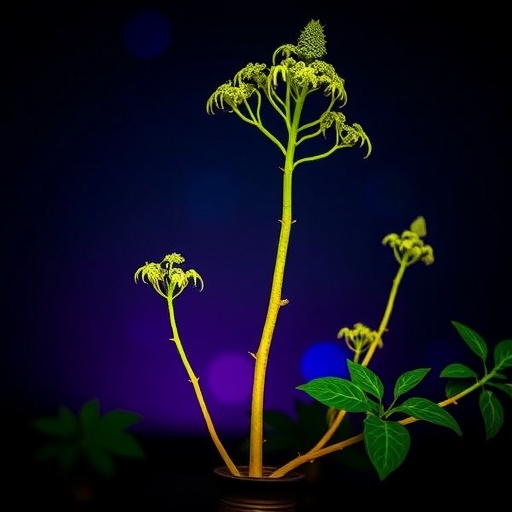The quest to unravel the complexities of plant genomes is becoming increasingly pivotal in the field of agricultural biotechnology. Among the vast array of plant species, Panax notoginseng, traditionally famed for its medicinal properties, has emerged as a key subject of genomic research. The identification and characterization of gene families within this species hold promise not only for enhancing our understanding of its biological functions but also for driving innovation in crop improvement and sustainable agriculture. Recent research has spotlighted the TIFY gene family—a group of genes known for their roles in plant stress responses and development. Comprehensive studies on these genes could revolutionize how we perceive plant resilience and adaptability.
In the study conducted by Yang et al., the team embarked on a genome-wide exploration of the TIFY gene family in Panax notoginseng. The TIFY gene family is notable for its implications in various biological processes, including response to environmental stimuli, hormone signaling, and developmental pathways. This research sheds light on how Panax notoginseng, a plant that has been revered in traditional medicine for centuries, may be genetically equipped to withstand environmental challenges. Understanding this gene family could lead to advancements in breeding programs aimed at enhancing stress resistance in crops.
The methodology employed in this study is rigorous and multifaceted, involving extensive bioinformatics analyses alongside wet-lab experiments. Genome-wide identification began with the mining of genetic databases, followed by the use of advanced computational tools to predict the presence of the TIFY gene family members. This approach allowed for the exhaustive characterization of these genes, revealing their structure and conserved domains, which are critical to their function. The researchers meticulously cataloged various TIFY genes, providing a detailed profile that distinguishes them within the plant’s genetic framework.
Once identified, the researchers turned their attention to expression profiling, examining how these TIFY genes behave under different physiological conditions. The ability to measure gene expression in plant tissues under various environmental triggers, such as drought or pathogen attack, is fundamental in understanding their functional roles. This part of the research is particularly exciting, as it opens doors to deciphering how plants regulate their response mechanisms at a molecular level. The findings suggest that specific TIFY members are significantly induced under stress conditions, indicating their potential as targets for genetic manipulation to enhance stress tolerance.
Moreover, the research introduces innovative techniques for expression analysis using RNA sequencing. This high-throughput approach has transformed the way scientists can analyze gene expression profiles, providing an in-depth understanding of the temporal and spatial expression patterns of TIFY genes throughout different stages of plant growth and development. Such detailed insights are invaluable for constructing a comprehensive picture of how Panax notoginseng adapts to its environment and the underlying genetic mechanisms at play.
Additionally, the research evaluates the evolutionary context of the TIFY gene family. By analyzing orthologs and paralogs across various plant species, the authors illuminate the evolutionary dynamics that have shaped the functional diversity of these genes. This comparative analysis is crucial for understanding the adaptive significance of the TIFY family across different ecological niches. It highlights an intricate web of evolutionary pressures that influence not just the presence of these genes, but also their diverse roles in plant biology.
This study does not exist in isolation; it contributes to a growing body of literature that places Panax notoginseng at the center of plant genomic research. The researchers provide a comprehensive overview of previous studies on TIFY genes, contextualizing their findings within the broader framework of plant genomics. This synthesis not only enriches the current understanding of TIFY genes but also sets the stage for future explorations into their applications in crop science.
Furthermore, the authors discuss the implications of their findings for agricultural practices. As climate change poses unprecedented challenges for food security, the insights garnered from such genomic studies are increasingly important. The ability to identify and manipulate genes that confer stress resistance can lead to the development of resilient crop varieties that can thrive under adverse conditions. This research advocates for a paradigm shift in agricultural practices—one that embraces genomic technologies to ensure the sustainability of food production systems.
The publication of this research in BMC Genomics marks a significant milestone in the scientific discourse surrounding Panax notoginseng. Highlighting the role of TIFY genes serves as a clarion call for further investigation into the genetic resources available within this important medicinal plant. It invites researchers, plant breeders, and agrobiotechnologists to leverage these findings towards enhancing the robustness of crops, ultimately contributing to sustainable agricultural practices.
The attention to detail in this study underscores the meticulous nature of modern genetic research. As scientists push the boundaries of what is possible through genomic analyses, the incorporation of multidisciplinary tools and approaches becomes essential. The synergy of bioinformatics and experimental biology depicted in this research exemplifies how collaborative efforts can facilitate breakthroughs in our understanding of complex genetic systems.
In conclusion, Yang et al.’s study serves as a pivotal contribution to the ongoing exploration of plant genomes, particularly as they relate to environmental adaptability and resilience. By unveiling the intricacies of the TIFY gene family in Panax notoginseng, the researchers not only document important genetic resources but also lay the groundwork for harnessing these insights in practical applications. The age of genomics is upon us, and as we delve deeper into the genetic blueprints of plants, the potential for enhancing agricultural resilience has never been clearer.
Subject of Research: TIFY gene family in Panax notoginseng
Article Title: Genome-wide identification, characterization, and expression profiling of TIFY family members in Panax notoginseng
Article References: Yang, Y., Qu, Y., Li, X. et al. Genome-wide identification, characterization, and expression profiling of TIFY family members in Panax notoginseng. BMC Genomics 26, 933 (2025). https://doi.org/10.1186/s12864-025-12140-5
Image Credits: AI Generated
DOI:
Keywords: TIFY gene family, Panax notoginseng, genomics, stress resistance, crop improvement.




